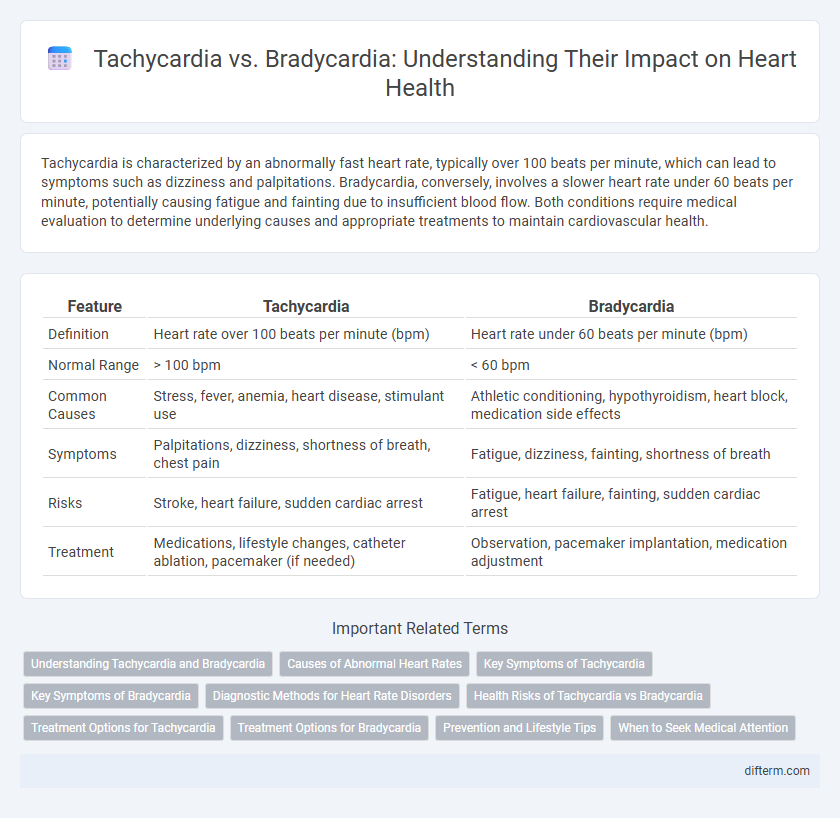Tachycardia is characterized by an abnormally fast heart rate, typically over 100 beats per minute, which can lead to symptoms such as dizziness and palpitations. Bradycardia, conversely, involves a slower heart rate under 60 beats per minute, potentially causing fatigue and fainting due to insufficient blood flow. Both conditions require medical evaluation to determine underlying causes and appropriate treatments to maintain cardiovascular health.
Table of Comparison
| Feature | Tachycardia | Bradycardia |
|---|---|---|
| Definition | Heart rate over 100 beats per minute (bpm) | Heart rate under 60 beats per minute (bpm) |
| Normal Range | > 100 bpm | < 60 bpm |
| Common Causes | Stress, fever, anemia, heart disease, stimulant use | Athletic conditioning, hypothyroidism, heart block, medication side effects |
| Symptoms | Palpitations, dizziness, shortness of breath, chest pain | Fatigue, dizziness, fainting, shortness of breath |
| Risks | Stroke, heart failure, sudden cardiac arrest | Fatigue, heart failure, fainting, sudden cardiac arrest |
| Treatment | Medications, lifestyle changes, catheter ablation, pacemaker (if needed) | Observation, pacemaker implantation, medication adjustment |
Understanding Tachycardia and Bradycardia
Tachycardia is characterized by a heart rate exceeding 100 beats per minute, often caused by stress, fever, or heart-related conditions, while bradycardia refers to a slower than normal heart rate, typically below 60 beats per minute, and may indicate issues with the heart's electrical system or high physical fitness levels. Recognizing symptoms such as dizziness, fatigue, or palpitations is critical for diagnosing these arrhythmias accurately. Effective management involves monitoring heart function through ECG and addressing underlying causes to prevent complications like heart failure or stroke.
Causes of Abnormal Heart Rates
Tachycardia commonly arises from stress, fever, anemia, or hyperthyroidism, causing an abnormally fast heart rate exceeding 100 beats per minute. Bradycardia, characterized by a heart rate below 60 beats per minute, often results from heart block, hypothyroidism, or aging-related degeneration of the cardiac conduction system. Both conditions reflect disruptions in the heart's electrical signaling influenced by physiological or pathological factors affecting normal rhythm.
Key Symptoms of Tachycardia
Tachycardia is characterized by an abnormally fast heart rate, typically exceeding 100 beats per minute in adults, leading to symptoms such as palpitations, dizziness, shortness of breath, and chest pain. Unlike bradycardia, which involves a slow heart rate below 60 beats per minute, tachycardia symptoms often indicate an overactive cardiac rhythm that can strain the heart. Recognizing these key symptoms promptly is crucial for diagnosing and managing conditions like atrial fibrillation, supraventricular tachycardia, or ventricular tachycardia.
Key Symptoms of Bradycardia
Bradycardia is characterized by a heart rate below 60 beats per minute, leading to symptoms such as fatigue, dizziness, and shortness of breath due to inadequate blood flow. Patients often experience weakness, confusion, and fainting spells, which result from insufficient oxygen delivery to the brain and other vital organs. Diagnosing bradycardia requires monitoring heart rhythms through electrocardiograms (ECGs) to detect slowed electrical conduction linked to conditions like heart block or sinoatrial node dysfunction.
Diagnostic Methods for Heart Rate Disorders
Electrocardiogram (ECG) is the primary diagnostic tool for distinguishing tachycardia from bradycardia by recording the heart's electrical activity and identifying abnormal heart rhythms. Holter monitors provide continuous ECG monitoring over 24-48 hours to detect intermittent arrhythmias that may be missed during a standard ECG. Tilt table tests and event monitors further assist in diagnosing underlying causes and correlating symptoms with heart rate abnormalities.
Health Risks of Tachycardia vs Bradycardia
Tachycardia poses health risks such as increased likelihood of stroke, heart failure, and sudden cardiac arrest due to the heart beating too rapidly, which reduces its efficiency in pumping blood. Bradycardia, characterized by a slower than normal heart rate, can lead to symptoms like fatigue, dizziness, fainting, and in severe cases, heart failure due to insufficient blood flow to the body. Both conditions require medical attention to manage risks and prevent complications related to impaired cardiac function.
Treatment Options for Tachycardia
Treatment options for tachycardia include medications such as beta-blockers, calcium channel blockers, and antiarrhythmic drugs to control heart rate and rhythm. In more severe cases, procedures like catheter ablation, electrical cardioversion, or implantation of a pacemaker or defibrillator may be necessary. Lifestyle modifications, including stress reduction, avoiding stimulants, and managing underlying conditions, also play a critical role in managing tachycardia effectively.
Treatment Options for Bradycardia
Treatment options for bradycardia focus on addressing the underlying cause and may include medications like atropine to increase heart rate or temporary cardiac pacing in severe cases. Permanent pacemaker implantation is a common intervention for chronic or symptomatic bradycardia to maintain adequate heart rhythm. Lifestyle modifications and monitoring are also essential components of managing bradycardia in patients without significant symptoms.
Prevention and Lifestyle Tips
Maintaining a heart-healthy lifestyle with regular exercise, a balanced diet low in sodium and saturated fats, and stress management helps prevent both tachycardia and bradycardia. Avoiding stimulants such as caffeine, nicotine, and excessive alcohol reduces the risk of abnormal heart rhythms, while regular medical check-ups enable early detection and management of underlying conditions like hypertension or thyroid disorders. Adequate sleep and hydration support optimal cardiac function and contribute to long-term heart rate stability.
When to Seek Medical Attention
Seek medical attention for tachycardia when experiencing persistent heart rates above 100 beats per minute accompanied by dizziness, chest pain, or shortness of breath. Bradycardia requires prompt evaluation if the heart rate falls below 60 beats per minute with symptoms like fatigue, confusion, or fainting spells. Early diagnosis and treatment of abnormal heart rhythms reduce the risk of complications such as heart failure or stroke.
Tachycardia vs Bradycardia Infographic

 difterm.com
difterm.com